________________ The Concept of Paryaya and Jaina Way of Life 53 permanent and transitory. The Buddhist denies a permanent self underlying the course of psychical events which happen in different times. What exists and is possible is only the present momentary unit. The past is defunct, and the present is lost after its turn. This makes the continuity of personal life impossible, and consequently the continuity of present life into the future and the necessity of the law of karma that the performer of good or bad act will have to bear the consequences become impossible of explanation.33 The Jaina holds that causal efficiency is not consistent with the principle of momentariness (Ksanikavada) - although the Buddhist himself treats causal efficiency as the very essence of his principle. Causal efficiency, according to Jaina view, cannot function successively owing to the fact that the momentary existence (ksanas) lacks an abiding nature and hence can have neither spatial nor temporal duration. Succession - spatial or temporal - involves the notions of "before" and "after" which are absent from the moment.34 Unwilling to admit this reality of any eternal soul substance, the Buddhists and David Hume interpreted consciousness as consisting of only discrete impressions, ideas or experiences which would be 'fleeting without any abiding substratum. Such an approach naturally gives rise to the problem of self-identity since there is nothing in common between the discrete sensations or experiences. In fact, both Buddhism and David Hume attempted to account for self-identity on the basis of the rapidity of the succeeding impressions or sensations. For instance, David Hume says: "The self is an ensemble of feelings, perceptions, dispositions and awareness that serves as the vehicle for Karma."35 He further states: "The self is nothing but a bundle or collection of different perceptions, succeeding each other with an inconceivable rapidity and are in a perpetual flux and movement." Buddha's attempt to improve upon Hume by stating that these different perceptions, dispositions, etc. are "internally related phenomena" and "interdependent" also did not solve the problem of self-identity. These attempts to account for self-identity are not satisfactory, since the impressions being basically disconnected and lacking any abiding agency of the Self as substratum cannot account for 'real' selfidentity, whatever be the rapidity of their succession. Accordingly, any




